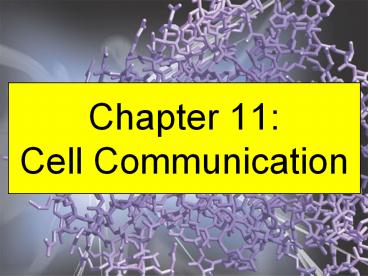Chapter 11: Cell Communication - PowerPoint PPT Presentation
1 / 33
Title:
Chapter 11: Cell Communication
Description:
This chapter's emphasis is on signals that are released ... Diffusion ... Free diffusion between cells. Distant cells (hormones) Adjacent cells (within ... – PowerPoint PPT presentation
Number of Views:54
Avg rating:3.0/5.0
Title: Chapter 11: Cell Communication
1
Chapter 11Cell Communication
2
Important Point
If you are having trouble understanding lecture
material Try reading your text before
attending lectures. And take the time to read it
well!
3
Signal-Transduction Emphasis
- This chapters emphasis is on signals that are
released from one cell and allowed to freely
diffuse to a second (or more) recipient cell(s) - These communications are deliberately initiated,
received, and interpreted in order to increase
the physiological coordination of the cells in
multicellular organisms - We will consider in particular those events that
follow the reception of a chemical signal - We will not dwell on the purpose of the signal
- We also will not dwell on why and how a given
cell releases a given signal
4
Signaling with Direct Contact
5
Local Signaling w/o Direct Contact
e.g., interferon release by viral-infected cells
6
Long-Distance Signaling
7
Long-Distance Diffusion
Note how specificity is determined by
presence/absence of receptor protein
8
Signalling, Free-Living Cells
9
Cell-Cell Chemical Signaling
- Three general categories of chemical signaling
- Cytoplasmic connections between cells
- Cell-to-cell contact-mediated signaling
- Free diffusion between cells
- Distant cells (hormones)
- Adjacent cells (within interstitial space)
- All of latter involves the physical movement of
ligands - That is, ligand reception by a protein
- Note that reception means molecule-to-molecule
contact
10
Ligands
e.g., nitric oxide
e.g., steroid hormones
Nothing to memorize on this page
e.g., insulin
e.g., epinephrine
11
Signal Transduction
Often turning on or off enzyme activity
In this case the receptor protein is a membrane
protein
Ligand
12
Three Stages
2a. Transduction
2b. Transduction
2c. Transduction
2d. Transduction
Responses usually involve increasing or
decreasing some proteins function
13
Three Stages
1. Reception
2a. Transduction
2b. Transduction
3. Response
14
Intracellular Receptor
15
Rapidity of Response
Slower response if requiring protein synthesis
16
G-Protein-Linked Receptor
G proteins bind GTP
17
G-Protein-Linked Receptor
The more ligand binding, the greater the cellular
response
Note lability of all signals
18
Protein Kinase Phosphatase
Therefore, responses tend to continue (or expand)
only so long as signaling continues
This reversibility contributes to the dynamic
nature of cells
Like signal lability, reversibility of
phosphorylation makes signaling reversible
19
Tyrosine Kinase Receptor
20
Receptor Tyrosine Kinase
- Note steps involved
- Ligand Reception
- Receptor Dimerization
- Catalysis (Phosphorylization)
- Subsequent Protein Activation
- Further Transduction
- Response
21
Ion-Channel Receptor
Reversibility is assured by pumping ions back out
again (using separate protein)
22
Phosphorylation Cascade
23
Cyclic AMP (cAMP)
Note reversibility
Second Messenger
Second messengers are not proteins
24
2nd Messenger, S.T.P.
25
Ca2-mediated Signal Amp.
Releasing Ca2 is a means of greatly amplifying
signal
26
Signal Amplification (Cascade)
27
Signal Amplification (Cascade)
28
Signal Amplification (Cascade)
29
Signal-Transduction Cascade
Seek to understand the concept, rather than
memorize the specific protein
30
Nuclear Response
31
Various Responses
Note that more than one response can result from
the reception of a single ligand
32
Various Responses
- Same ligand gives rise to different responses
- (here same receptor, different relay)
- Cells differ in terms of their proteins
- Different proteins respond differently to the
same environmental signals
33
The End































